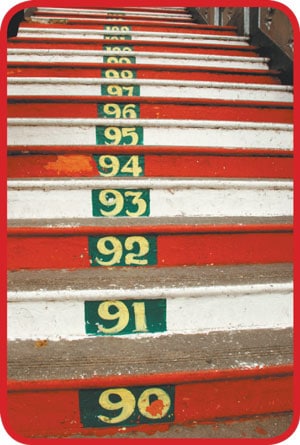
So I admit I’m a stair-counter. I can’t go up or down stairs without counting them. For example, I just happen to know that there are 19 steps up for each floor to get to my daughter’s apartment.
But when I have the same set up steps over and over again, like I do at home, I need to subdivide in order to break the boredom. So I’ve got 15 steps to go up and down. For a while I counted 4-4-4-3, which has a nice little cadence (count it in your head – I think you’ll see what I mean). Then it was 3-3-3-3-3, which is rather waltzy, so it was fun for a while. But when I went with 5-5-5, that worked well for the front (straight) staircase, but the back didn’t work because there is a landing, splitting the bottom flight of 9 and the top flight of 6, and one certainly can’t break up a subdivision over a landing, so the only one that works on the back is the 3-3-3-3-3, or simply to go with 9-6 upwards and 6-9 downwards, but that seemed to me rather pedantic. So I came up with 5-4-3-2-1. Eureka! It works both ways in the front, and in the back I can do 5-4-3-2-1 upward and 1-2-3-4-5 downward.
Believe it or not, this got me to thinking about how we can use our normal activities to reinforce our math in our day-to-day lives. A couple of months ago I gave some ideas about how to keep your child’s math brain working over the summer. (Take a look at the March issue of Knoxville Parent online!). Here are a few more ideas that you can use, many of them virtually every day!
“Believe it or not, this got me to thinking about how we can use our normal activities to reinforce our math in our day-to-day lives.”
Next time you go to the store, when you get out of the car, ask how many steps it will take to get to the door of the store. Two ways to play: counting backward from the estimated number or forward from 1. Either way, after walking, calculate how far off the estimate was.
Or how about this? Count your steps by 2’s, by 3’s, by 4’s, etc. Once at the door, figure out how many steps it was if you had been counting by 1’s. If this is too tough for your younger one, let him start by saying the skip numbers while whispering the others. That is, to count by 3’s, as he walks he whispers “One, two,” then on the third step says aloud, “three,” whispers, “four, five,” then aloud “six,” and so forth. After trying that a few times he can whisper, “one, two” and only step when he says the “three” aloud (and “six” and “nine” and so forth).
Now you can throw a wrench in the works! Count by threes, but start at two! 2, 5, 8, 11, etc. Or by fours, starting at 1. 1, 5, 9, 13, etc.
But if your child is a little older, you can still do counting games – just make it a little more mind-bending. How about count by 1 1/2? Or count by 3/4. Or just do any one of these backwards!
Of course skip-counting is an entrée to multiplying, so for the more advanced students you might want to speed things up a bit. Jump rope or jog calling out multiples (3, 6, 9, etc.). Throw a Frisbee in the air and see how far she can go before it’s caught. Catch lightening bugs and figure out how many lightening bug legs he’s caught. Get out a deck of cards and play “war,” but each player has to draw two (or three or four) cards and multiply them together to see who has the bigger number.
Numerical fluency is very important, and if your child is only practicing it while in a formal math setting (classroom or homework), it will never flow like it should. I naturally count stairs and the like, but if I didn’t, I would need someone to give me the idea!
Related posts
Newsletter Subscribe
Newest Posts
Set Up a Parental Control for Online Safety
Have you ever wondered how long your children spend in front of a device without your supervision? Yes, it is…
Adopt A Life, Save A Life
By Jeff Ashin, CEO, Young-Williams Animal Center. Photo by: Young-Williams Animal Center Are you or your child thinking of adding…

